Saturday, 29 May 2010
Friday, 28 May 2010
Lip Sync Task
I used Final Cut to edit the Lip Sync Task. It was simple to use and has overall helped me to understand the software which means that I will be familiar, and more comfortable, with using the software when it comes to creating my own music video.

This is the browser window on the Final Cut software. It is where all of the clips and sounds that I filmed go. As you can see above, there is the soundtrack which I used, Paramore - Emergency. I got this soundtrack from www.zamzar.com. I had lots of footage to get through, and a few selections of footage which I used are in the browser box above. It was simple to put the parts of footage into my piece, all I had to do was choose the clips that I wanted and drag them down to the timeline.

The timeline is made up of layers, the two bottom green strips are where my soundtrack is. I used one of the tools at the bottom left to add the wavelengths onto the strips so that it was easier for me to sync it with the video. The two small red markers show the start of the singing in the song, so that I knew where to start the footage of that particular bit. You can lock each layer whilst editing another strip, by using the padlock tool at the beginning, to the left of each layer. Also you can mute each layer so that you can focus on just one sound part at a time which I found useful when i was using the razor tool to split the video layer.
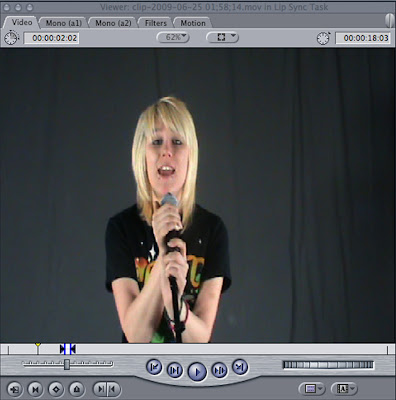
This is the first window where I selected the particular parts of each clip which I wanted to use, I could pick them out by using the in and out markers, which are the two small blue points. Then I just had to drag the selected footage to the timeline. Here, I could also change the motion of the footage whether that be distort, crop, rotation, blur and opacity.
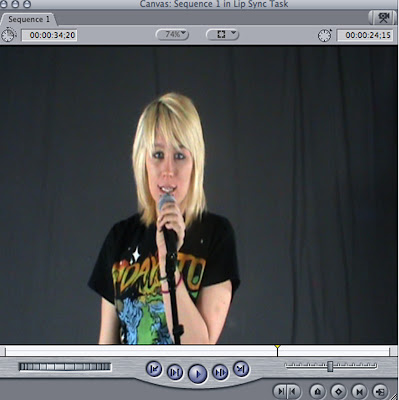
This is the second window where the footage from the timeline is played. I found that here I could also play my footage in slow motion so that I could find any problems with my footage easily enough.
I think that experimenting with Final Cut now, I have gained an advantage when it comes to editing my real music video, as I now have a feel and a better understanding of the software.

This is the browser window on the Final Cut software. It is where all of the clips and sounds that I filmed go. As you can see above, there is the soundtrack which I used, Paramore - Emergency. I got this soundtrack from www.zamzar.com. I had lots of footage to get through, and a few selections of footage which I used are in the browser box above. It was simple to put the parts of footage into my piece, all I had to do was choose the clips that I wanted and drag them down to the timeline.

The timeline is made up of layers, the two bottom green strips are where my soundtrack is. I used one of the tools at the bottom left to add the wavelengths onto the strips so that it was easier for me to sync it with the video. The two small red markers show the start of the singing in the song, so that I knew where to start the footage of that particular bit. You can lock each layer whilst editing another strip, by using the padlock tool at the beginning, to the left of each layer. Also you can mute each layer so that you can focus on just one sound part at a time which I found useful when i was using the razor tool to split the video layer.

This is the first window where I selected the particular parts of each clip which I wanted to use, I could pick them out by using the in and out markers, which are the two small blue points. Then I just had to drag the selected footage to the timeline. Here, I could also change the motion of the footage whether that be distort, crop, rotation, blur and opacity.

This is the second window where the footage from the timeline is played. I found that here I could also play my footage in slow motion so that I could find any problems with my footage easily enough.
I think that experimenting with Final Cut now, I have gained an advantage when it comes to editing my real music video, as I now have a feel and a better understanding of the software.
Thursday, 27 May 2010
Inspiration
I was initially inspired by the OK diner and my original thoughts were to film here, but after looking around I found that Happy Daze was more suitable.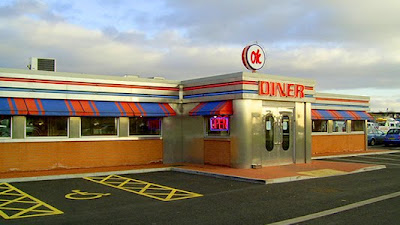
I wanted the persona to have a look of a stereotypical 50's style. Christina Aguilera portrays this well in 'Candy Man' and my characters look is similar, based on this.
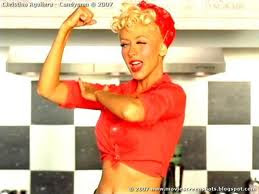

I wanted the persona to have a look of a stereotypical 50's style. Christina Aguilera portrays this well in 'Candy Man' and my characters look is similar, based on this.

Another clip from 'Candy Man' with milkshakes, which were popular in american diners around the 50's and I hoped to have a milkshake as a prop in the video just for authenticity.
 This 16-frame shows clips from the saturdays comic relief video, and gave me an overall idea of the type of shots include throughout my music video, and I found this video a useful reference because of the old 50's style, similar to the style I wanted to do.
This 16-frame shows clips from the saturdays comic relief video, and gave me an overall idea of the type of shots include throughout my music video, and I found this video a useful reference because of the old 50's style, similar to the style I wanted to do.
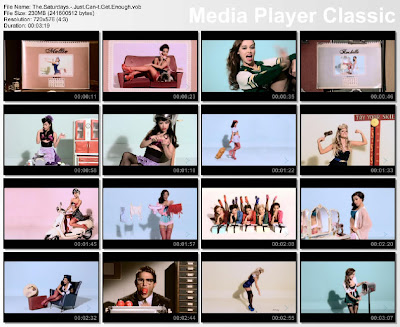
 This 16-frame shows clips from the saturdays comic relief video, and gave me an overall idea of the type of shots include throughout my music video, and I found this video a useful reference because of the old 50's style, similar to the style I wanted to do.
This 16-frame shows clips from the saturdays comic relief video, and gave me an overall idea of the type of shots include throughout my music video, and I found this video a useful reference because of the old 50's style, similar to the style I wanted to do.
Sunday, 23 May 2010
Research into the history of Rock and Roll.
In 1945, World War II ended. By 1946, American servicemen began returning home to start up the families they had had to put on hold for 4 years. Thus began the unusually large bubble in the population curve of America known as the Baby Boom, as millions of babies were born all of a sudden in the span of five to ten years. What that means is that American society would suddenly find itself catering to a generation of young people in a way that had never occurred before.
Sixties rock finds its roots in several places, starting as far back as the big swing bands of the pre-war era that the 60's kids' parents listened to as youngsters: Glenn Miller, Benny Goodman, Count Basie, Tommy and Jimmy Dorsey, and Duke Ellington's bands are some of the most famous. Except for Duke Ellington, all those bands were primarily dance bands, with big swinging backbeats.
There were also the smaller, "rhythm combo" groups, usually of only four or five players. Their tunes were popular on the jukeboxes of the day, but were not considered artistically important which is why we have mostly forgotten them today.
Then there was Country & Western--especially what was called "Texas Swing," of which Bob Wills & the Texas Playboys was the king. Hank Williams Sr. was another important singer/songwriter of that era and genre.
Over in Memphis there was Sam Phillips and his Sun Studios, where rockabilly and Elvis Presley were born. Besides Presley, Jerry Lee Lewis, Carl Perkins, Johnny Cash and Roy Orbison all began their recording careers at Sun Studios.
Two other sources of modern rock'n'roll, absolutely essential to the sound we think of as 60's rock, were, first, the Blues. Blues began as the music of black sharecroppers in the poor cotton-farming region of the Mississippi Delta, and traveled north to Chicago with the sharecroppers as thousands of them moved north in search of a better life. It was in Chicago that the blues went from acoustic solo guitar music to electric guitar-electric bass-drums combos. Muddy Waters, Little Milton, B.B. King, and Howlin' Wolf were just a few of these important Chicago blues artists.
Source: http://www.spectropop.com/hmadanibrief.html
Sixties rock finds its roots in several places, starting as far back as the big swing bands of the pre-war era that the 60's kids' parents listened to as youngsters: Glenn Miller, Benny Goodman, Count Basie, Tommy and Jimmy Dorsey, and Duke Ellington's bands are some of the most famous. Except for Duke Ellington, all those bands were primarily dance bands, with big swinging backbeats.
There were also the smaller, "rhythm combo" groups, usually of only four or five players. Their tunes were popular on the jukeboxes of the day, but were not considered artistically important which is why we have mostly forgotten them today.
Then there was Country & Western--especially what was called "Texas Swing," of which Bob Wills & the Texas Playboys was the king. Hank Williams Sr. was another important singer/songwriter of that era and genre.
Over in Memphis there was Sam Phillips and his Sun Studios, where rockabilly and Elvis Presley were born. Besides Presley, Jerry Lee Lewis, Carl Perkins, Johnny Cash and Roy Orbison all began their recording careers at Sun Studios.
Two other sources of modern rock'n'roll, absolutely essential to the sound we think of as 60's rock, were, first, the Blues. Blues began as the music of black sharecroppers in the poor cotton-farming region of the Mississippi Delta, and traveled north to Chicago with the sharecroppers as thousands of them moved north in search of a better life. It was in Chicago that the blues went from acoustic solo guitar music to electric guitar-electric bass-drums combos. Muddy Waters, Little Milton, B.B. King, and Howlin' Wolf were just a few of these important Chicago blues artists.
Source: http://www.spectropop.com/hmadanibrief.html
Saturday, 22 May 2010
The purpose of a Music Video and History Research.
A brief history:
1800s:
When sheet music publishers still ran the music business, Edward B. Marks and Joe Stern hired electrician George Thomas and various performers to promote sales of their song The Little Lost Child. Thomas projected a series of still images on a screen simultaneously with live performances in what became a popular form of entertainment known as the illustrated song. This has been termed the first music video. Even today, many music videos and much contemporary television still use series of still images accompanied by song.
1900s/The Beatles:
One of the earliest performance clips in 1960s pop was the promo film made by The Animals for their breakthrough 1964 hit "House Of The Rising Sun". This high-quality colour clip was filmed in a studio on a specially-built set; it features the group in a lip-synched performance, depicted through an edited sequence of tracking shots, closeups and longshots, as singer Eric Burdon, guitarist Hilton Valentine and bassist Chas Chandler walked around the set in a series of choreographed moves.
Music Videos really broke through since 1964 with the Beatles and the release of their first feature film 'A Hard Days Night' which contains a number of musical sequences which had a huge influence.
The colour promotional clips for "Strawberry Fields Forever" and "Penny Lane", made in early 1967 and directed by Peter Goldman took the promotional film format to a new level. They used techniques borrowed from underground and avant garde film, including reversed film and slow motion, dramatic lighting, unusual camera angles and color filtering added in post-production. Reflecting the fact that these studio masterpieces were impossible for the group to perform live, their psychedelic mini-films illustrated the songs in an artful, impressionistic manner rather than trying to simulate an idealised performance or depict a narrative or plot.
At the end of 1967 the group released their third film, the one hour, made-for-television project Magical Mystery Tour; it was written and directed by the group and first broadcast on the BBC on Boxing Day 1967. Although poorly received at the time for lacking a narrative structure, it showed the group to be accomplished music video makers in their own right. It included elaborate edited sequences for the new songs featured in the film and the clips for "I Am The Walrus" and "Your Mother Should Know" have been screened many times on music TV shows in later years.
1980s:
Music Videos went mainstream. In 1981, the U.S. video channel MTV launched, airing "Video Killed the Radio Star" and beginning an era of 24-hour-a-day music on television. With this new outlet for material, the music video would, by the mid-1980s, grow to play a central role in popular music marketing. Many important acts of this period, most notably Adam and the Ants, Duran Duran and Madonna, owed a great deal of their success to the skillful construction and seductive appeal of their videos.
(THE ABOVE RESEARCH IS TAKEN FROM http://en.wikipedia.org/wiki/Music_video)
The main purpose of a video is to promote the artist and leave the audience remembering the song. However, a music video serves other purposes aimed for by the creators; entertainment.
Quotes for the Music:
'Music is the vernacular of the human soul.'
Author: Geoffrey Latham
'Music is your own experience, your own thoughts, your wisdom. If you don’t live it, it won’t come out of your horn. They teach you there’s a boundary line to music. But, man, there’s no boundary line to art.'
Author: Charlie Parker
'Where words fail, music speaks.'
Author: Hans Christian Anderson
'Joy, sorrow, tears, lamentation, laughter — to all these music gives voice, but in such a way that we are transported from the world of unrest to a world of peace, and see reality in a new way, as if we were sitting by a mountain lake and contemplating hills and woods and clouds in the tranquil and fathomless water.'
Author: Albert Schweitzer
Music Video Quotes:
- 'The visual must be predetermined, but the emotion can't be.'
- 'When you shoot on film. you have to make your choice as you shoot.'
- 'I looked at the rhythms, and I replicated an abstraction, which made my videos closer to what the musicians usually meant in the beginning. I could never be exact in my work, and that was a good thing.'
-'They didn't have to be filled out with fast editing or crazy angles, so that was one of my first rules: Not necessarily to get that nostalgic look, but more to have a commitment to the shot'.
- We'll do a crazy video of a great song that people can actually dance to.'
1800s:
When sheet music publishers still ran the music business, Edward B. Marks and Joe Stern hired electrician George Thomas and various performers to promote sales of their song The Little Lost Child. Thomas projected a series of still images on a screen simultaneously with live performances in what became a popular form of entertainment known as the illustrated song. This has been termed the first music video. Even today, many music videos and much contemporary television still use series of still images accompanied by song.
1900s/The Beatles:
One of the earliest performance clips in 1960s pop was the promo film made by The Animals for their breakthrough 1964 hit "House Of The Rising Sun". This high-quality colour clip was filmed in a studio on a specially-built set; it features the group in a lip-synched performance, depicted through an edited sequence of tracking shots, closeups and longshots, as singer Eric Burdon, guitarist Hilton Valentine and bassist Chas Chandler walked around the set in a series of choreographed moves.
Music Videos really broke through since 1964 with the Beatles and the release of their first feature film 'A Hard Days Night' which contains a number of musical sequences which had a huge influence.
The colour promotional clips for "Strawberry Fields Forever" and "Penny Lane", made in early 1967 and directed by Peter Goldman took the promotional film format to a new level. They used techniques borrowed from underground and avant garde film, including reversed film and slow motion, dramatic lighting, unusual camera angles and color filtering added in post-production. Reflecting the fact that these studio masterpieces were impossible for the group to perform live, their psychedelic mini-films illustrated the songs in an artful, impressionistic manner rather than trying to simulate an idealised performance or depict a narrative or plot.
At the end of 1967 the group released their third film, the one hour, made-for-television project Magical Mystery Tour; it was written and directed by the group and first broadcast on the BBC on Boxing Day 1967. Although poorly received at the time for lacking a narrative structure, it showed the group to be accomplished music video makers in their own right. It included elaborate edited sequences for the new songs featured in the film and the clips for "I Am The Walrus" and "Your Mother Should Know" have been screened many times on music TV shows in later years.
1980s:
Music Videos went mainstream. In 1981, the U.S. video channel MTV launched, airing "Video Killed the Radio Star" and beginning an era of 24-hour-a-day music on television. With this new outlet for material, the music video would, by the mid-1980s, grow to play a central role in popular music marketing. Many important acts of this period, most notably Adam and the Ants, Duran Duran and Madonna, owed a great deal of their success to the skillful construction and seductive appeal of their videos.
(THE ABOVE RESEARCH IS TAKEN FROM http://en.wikipedia.org/wiki/Music_video)
The main purpose of a video is to promote the artist and leave the audience remembering the song. However, a music video serves other purposes aimed for by the creators; entertainment.
Quotes for the Music:
'Music is the vernacular of the human soul.'
Author: Geoffrey Latham
'Music is your own experience, your own thoughts, your wisdom. If you don’t live it, it won’t come out of your horn. They teach you there’s a boundary line to music. But, man, there’s no boundary line to art.'
Author: Charlie Parker
'Where words fail, music speaks.'
Author: Hans Christian Anderson
'Joy, sorrow, tears, lamentation, laughter — to all these music gives voice, but in such a way that we are transported from the world of unrest to a world of peace, and see reality in a new way, as if we were sitting by a mountain lake and contemplating hills and woods and clouds in the tranquil and fathomless water.'
Author: Albert Schweitzer
Music Video Quotes:
- 'The visual must be predetermined, but the emotion can't be.'
- 'When you shoot on film. you have to make your choice as you shoot.'
- 'I looked at the rhythms, and I replicated an abstraction, which made my videos closer to what the musicians usually meant in the beginning. I could never be exact in my work, and that was a good thing.'
-'They didn't have to be filled out with fast editing or crazy angles, so that was one of my first rules: Not necessarily to get that nostalgic look, but more to have a commitment to the shot'.
- We'll do a crazy video of a great song that people can actually dance to.'
Friday, 21 May 2010
Warhol Self

To create my Warhol self, I used photoshop. I began with a photo of myself and, using the magnetic lasso tool, I cut around my shape and then copied it onto a new layer, then I blurred the picture and used some tools, including the burn tool, to change the colour, texture and look of my cutout, then I played around with the saturation levels to create the overall finished Warhol-self.
Opie-self
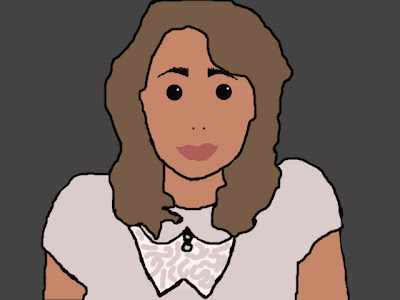
To create my Opie Self I used Photoshop. I started by using a photo of myself and then using the magnetic lasso tool to cut out parts and move them onto a new layer. I started with my hair, then my face and neck, and then my t-shirt. With each piece I used the tester tool to draw a colour from my hair/skin/clothes, then i selected the paint bucket tool and colour filled each piece to create a painted, cartoon effect. After adding a layer for features I finished and then added a background to complete my Opie. I have learnt skills using photoshop which may show useful when starting the editing process of my music video.
Some Photoshop screen grabs to show the software I used to create my Opie-self and Warhol self:
The layers part where I added each section of my photo to colour over, and for my warhol self, to edit the colour and blur etc.
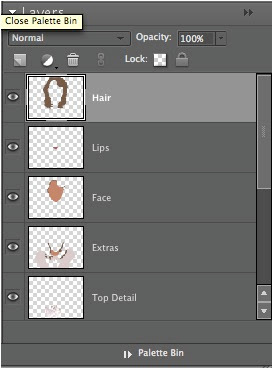
The tool section where I found useful tools such as the magnetic lasso tool and the paint bucket.

Subscribe to:
Comments (Atom)